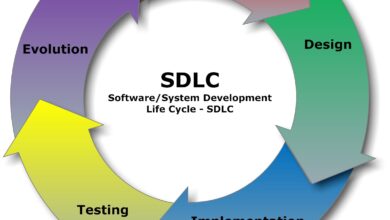Software development(SD) plays a crucial role in our modern digital landscape. SD is the backbone of technological innovation, from smartphone apps to online platforms. This article will analyze the world of SD, including its importance, phases, practices, abilities, challenges, possible trends, and more. Then let’s get going!
Software Development(SD) Overview
Both corporations and people require Software development. It helps businesses to streamline user interactions, increase productivity, and automate procedures. SD is the engine behind innovation and competitive advantage for all sizes of companies, from small startups to global conglomerates.

Importance of Software Development(SD)
For both organizations and people, SD is essential. Organizations can create seamless user experiences, increase efficiency, and automate operations. SD drives innovation and competitive advantage. Businesses of all sizes, including small startups, are affected by global corporations.
Different Phases of Software Development(SD)
-
Requirements Gathering
The first phase of SD is requirements gathering. To successfully meet someone’s needs and expectations, it’s essential to clearly understand what they require from stakeholders, define project goals, and document functional and non-functional requirements.
-
Design and Planning
Once the requirements are precise, the design and planning phase begins. This stage focuses on creating a blueprint for the software architecture, user interface, and data structures. It also involves identifying potential risks and developing a project timeline.
-
Coding and Implementation
The coding and implementation phase brings the design to life. Skilled developers write code based on the design specifications, following programming best practices. Programming knowledge in languages like Python, Java, C++, or JavaScript is necessary for this step.
-
Tests and Quality Control
For the program to work as intended, quality assurance is essential.
Testers conduct various tests, including functional, performance, and security testing. Bugs and issues are identified, reported, and fixed before proceeding to the next phase.
-
Deployment and Maintenance
The program is prepared for deployment after all tests are passed. The software is either installed on servers or made accessible for download during the deployment phase. Regular maintenance and updates ensure the software stays secure, functions smoothly, and remains compatible with the latest technologies.
Popular Software Development(SD) Methodologies
-
Waterfall Model
The waterfall model is a method of SD that follows a step-by-step sequence. It follows a linear progression, completing each phase before moving on to the next. This methodology works well for projects with stable requirements and clear objectives.
-
DevOps Approach
Development (Dev) and operations (Ops) are combined to form DevOps. It focuses on facilitating communication between IT operations teams and SD teams. Through continuous integration and deployment, the DevOps methodology seeks to automate procedures, boost effectiveness, and produce high-quality software.
-
Agile Methodology
The agile methodology emphasizes flexibility, collaboration, and iterative development. It breaks the project into smaller tasks or user stories, allowing continuous feedback and adaptation. Agile enables faster delivery, encourages customer involvement, and accommodates changing requirements.
Essential Skills and Roles in Software Development(SD)
-
Programming Languages
A crucial prerequisite for SD is linguistic proficiency. Python, Java, C#, Ruby, and JavaScript are well-known programming languages.Every language has advantages and lends itself well to particular tasks.
-
Tools for SD
The employment of a variety of technologies by developers helps them perform their jobs more efficiently. Features provided by Integrated Development Environments (IDEs) like PyCharm, Eclipse, and Visual Studio Code include version management, code editing, and debugging.
-
Roles of Developers, Testers, and Project Managers
SD involves various roles, including developers, testers, and project managers. Developers write the code and bring the software to life. Testers ensure the software functions as expected and identify any defects. Project managers oversee development, coordinate tasks, and ensure timely delivery.
Challenges in Software Development(SD)
Software development has its challenges. Let’s explore some common hurdles developers face:
-
Time and Resource Management
Managing time and resources is essential for successful SD. Setting realistic timelines, allocating resources effectively, and prioritizing tasks can help overcome these challenges.
-
Quality Assurance and Bug Fixing
Ensuring high-quality software is a continuous effort. Rigorous testing, bug tracking, and fixing are vital to delivering a reliable product. Implementing effective quality assurance processes helps identify and resolve issues promptly.
-
Managing Changing Requirements
Requirements may change during the development process. Having a flexible approach and being open to accommodating modifications are crucial. Effective communication with stakeholders is critical to managing changing requirements.
Future Trends in Software Development(SD)
SD is a field that is still evolving quickly. Here are some exciting future trends:
-
Artificial Intelligence and Machine Learning
AI and machine learning is transforming various industries. In SD, they enable intelligent automation, predictive analytics, and personalized user experiences. AI skills will promote creativity and efficiency when used in SD.
-
Internet of Things (IoT)
The IoT connects devices and enables data exchange. As IoT adoption grows, software developers will be crucial in creating applications that interact with connected devices. This opens up opportunities for developing intelligent home systems, industrial automation, and more.
-
Cloud Computing
Scalability, affordability, and flexibility are a few benefits of cloud computing. Businesses may use the benefits of cloud platforms by developing cloud-based apps. Serverless computing and containerization are gaining popularity, enabling developers to focus on code without worrying about infrastructure management.
Conclusion
Software development is a dynamic and essential field that powers the digital revolution. Developers produce ground-breaking software that reshapes our world when they have the appropriate abilities, approaches, and tools. Software engineers must keep up with the most recent developments and adjust to new difficulties as technology develops.
FAQs for Software Development
What are the phases of software development?
The phases of software development include requirements gathering, design and planning, coding and implementation, testing and quality control, and deployment and maintenance.
What are popular software development methodologies?
Popular methodologies include the waterfall model, DevOps approach, and agile methodology.
What are essential skills in software development?
Essential skills include proficiency in programming languages like Python and Java, as well as knowledge of tools and technologies for efficient development.
What are future trends in software development?
Future trends include the integration of AI and machine learning, the growth of IoT applications, and the adoption of cloud computing technologies.




